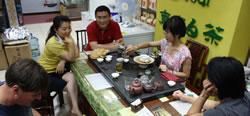Unexpected objects found in loose leaf teas
A recent case
 We have had a recent complaint from a customer who was genuinely upset because she found a couples of small sticks in the premium grade Dragon Well tea she purchased from us (shown in the image). She was upset because she understood the premium grade Dragon Well tea should only contain tip leaves, but not twigs – which is in the tea description. It took me quite some effort, inspections and sampling to convince her that the twigs are not part of the composition of the tea, but mixed in by accident which is not uncommon for a manually handled agricultural product like tea.
We have had a recent complaint from a customer who was genuinely upset because she found a couples of small sticks in the premium grade Dragon Well tea she purchased from us (shown in the image). She was upset because she understood the premium grade Dragon Well tea should only contain tip leaves, but not twigs – which is in the tea description. It took me quite some effort, inspections and sampling to convince her that the twigs are not part of the composition of the tea, but mixed in by accident which is not uncommon for a manually handled agricultural product like tea.
The cause
We are all aware that different categories of teas, green tea, white tea, Oolong tea, black tea, Pu-erh tea/Hei Cha and jasmine tea are processed differently. What is in common is that the premium loose teas are mostly handmade, in multiple stages and often carried out in the villages of the tea farmers with basic equipment. With manual work as such, very step and stage has the potential for some unwanted objects ‘to join in’.
The following link gives a glimpse of how manual it is to make a Pu-erh tea. The entire process of making a loose tea can take up days (some years if taking into account the after production storage period for the purpose of aging) with continuous manual involvement.
For those who have never witnessed an actual tea processing, finding a piece of human hair in the tea can certainly cause a panic which is understandable. For someone like me however who grew up with a tea culture like shown in the video clip, it is actually not so scary as I understand even with the best attempt by the tea farmers to avoid this, the chance of a piece hair fallen into the tea is rather high. For example, it is not really practical to expect the tea farms to ware factory caps when plucking the tea leaves in the tea fields or in the wild for teas like Pu-erh. If any human hair fell and mixed with tea leaves, unless it is spotted during the following stages and removed, it will show up when the tea is consumed. This is not to justify the existence of these foreign objects, but to explain how they happened.
https://www.youtube.com/watch?v=QE-aXKxPagY
Some examples of the foreign objects
Benign ones:
- Leaves of different grades, for example odd large old leaves
- Tea twigs
- Bamboo/straw pieces
- Corn kernels
- Tea flower seeds
More severe ones:
- Small screws
- Small insects
- Small feathers
- Human hair
- Tarpaulin fabric
How to minimise the potential harm
To start, the potential harm imposed by these objects are rather low mainly because we only consume the tea brew but not digesting the tea leave. We also always advise the following when preparing a tea brew:
- Inspect the dry tea leaves before adding to the tea vessel
- Rinse the tea leaves with hot water before brewing, especially those that are aged such as Pu-erh tea and Hei Cha
Final note:
- Some teas are more likely than the others to have these objects discovered. For example, there are regular reports of foreign objects found in Pu-erh cakes or bricks, largely due to the traditional processing methods and practices.
- The objects are not indicative of the quality grade of the teas. There might have been more attention paid to the exclusive grade tea products, but the potential of discovery of foreign objects still exists.
- The Chinese have consumed their teas exactly the same way for a long history. There is more concern caused the synthetic materials used in the agriculture - hazard caused by the foreign objects is almost unheard of.

